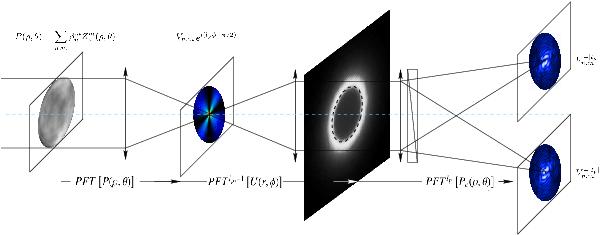Fig. 5

POAM diversity principle. The optical propagation is more complicated for a coronagraphic phase-mask. Indeed, this scheme presents three different polar propagations with the same entrance aberrated pupil, which is presented in the classical phase diversity system. The first polar Fourier transform is the same as for classical imaging (PFT[P(ρ,θ)]), but after the phase-mask coronagraph, the inverse polar Fourier transform including the VVC POAM properties becomes PFTlp, − 1[U(r,φ)]. In the coronagraphic pupil plane Pc(ρ,θ), the main part of stellar photons are rejected at the edge of the pupil and some of the remaining photons inside the pupil possess an added POAM ± lp. The final polar propagation PFTlp[Pc(ρ,θ)] gives the final attenuated coronagraphic image. An optical polarizing system (quarter waveplates and Wollaston) located after the Lyot stop (the circular dashed circle in the coronagraphic pupil) allows us to separate the two circular polarizations and then the two POAMs. This mathematical development gives a complete set of modal functions  .
.
Current usage metrics show cumulative count of Article Views (full-text article views including HTML views, PDF and ePub downloads, according to the available data) and Abstracts Views on Vision4Press platform.
Data correspond to usage on the plateform after 2015. The current usage metrics is available 48-96 hours after online publication and is updated daily on week days.
Initial download of the metrics may take a while.


